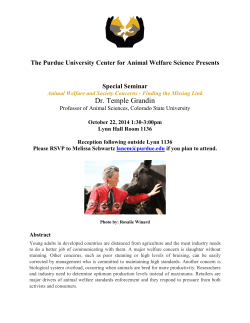
Reference Architecture for Enterprise Integration CIMOSA GRAI/GIM PERA Dima Nazzal
Reference Architecture for Enterprise Integration CIMOSA GRAI/GIM PERA Dima Nazzal Definitions Enterprise: a complex set of business processes that can be designed to accomplish a specific set of objectives. Enterprise integration (agile manufacturing, business process reengineering, CIM): The coordination of the operation of all elements of the enterprise working together in order to achieve the optimal fulfillment of the mission of that enterprise as defined by enterprise management.1 Architecture: A description (often graphical) of the structure of something 1. A structured plan, a framework on the basis of which a product or an organization of an enterprise can be constructed2 Definitions Reference model: a general model that can be used as a base to derive other models from. Reference Architecture: is a structured set of models which represent the building blocks of the system.3 Enterprise Integration Reference Architecture: is a framework in which enterprise related concepts are organized. The most known reference architectures are: CIMOSA, GRAI-GIM and PERA The Enterprise Model Requirements The enterprise model which fits the specific objectives of the particular enterprise should: identify the different processes in the enterprise. contain the machines, the information, the transfer of information, the human involvement and the functions that have to be carried out. address design activities, manufacturing processes, the way materials are ordered, moved and transformed into products. Enterprise Modeling Enterprise modeling has to fulfill several requirements to achieve efficient and effective enterprise integration: provide a modeling language easily understood by non-IT professionals, but sufficient for modeling complex industrial environments. provide a modeling framework which: covers the life cycle of enterprise operation from requirements definition to end of life. enables focus on different aspects of enterprise operation by hiding those parts of the model not relevant for the particular point of view. supports re-usability of models or model parts Open System Architecture for CIM - CIMOSA In 1985, the ESPRIT Consortium AMICE started to work on the definition and specification of a CIM architecture for enterprise integration. CIMOSA (completed in 1996) is premodeling solution which provides a framework based on the system life cycle concept CIMOSA CIMOSA Reference Architecture supports the description of the enterprise, from the management level to the shop floor level CIMOSA consists of: Enterprise modeling framework (reference architecture) Enterprise modeling language Integrating infrastructure CIMOSA Enterprise RA CIMOSA Enterprise Modeling Constructs (building blocks) CIMOSA Process Based Enterprise Modeling Domains with interacting Domain Processes CIMOSA Process Based Enterprise Modeling CIMOSA Process Based Enterprise Modeling Decomposition of a Domain Process into Business Processes and Enterprise Activities CIMOSA Process Based Enterprise Modeling CIMOSA Process Based Enterprise Modeling Domain Process Representation as a network of Enterprise Activities CIMOSA Process Based Enterprise Modeling CIMOSA Process Based Enterprise Modeling Functional Operations executed by Functional Entities (Resources) CIMOSA Process Based Enterprise Modeling FE1: vehicle controller FO1: set down vehicle FO2: clasp the lot X X FO3: pull up vehicle X CIMOSA Integrating Infrastructure The Integrating Infrastructure provides a set of service entities for model engineering and enterprise operation control. Relations between the Enterprise System Life Cycle and the progress of the modeling process GIM-GRAI Integrated Methodology Developed by the laboratory for automation and production at the university of Bordeaux- France since 1970’s. GIM is composed of the following elements: GRAI conceptual model: a representation of basic concepts of a manufacturing system decomposed into three sub-systems: physical system, decision and information system. GIM modeling framework (RA) with three dimensions: views, life cycle, and abstraction level. GIM structured approach: guide to show how to perform analysis and design of the manufacturing system in three main phases: analysis, user-oriented design, and technicaloriented design. GIM modeling formalisms (languages): GRAI grid and GRAI nets for decision system modeling, IDEF0 and stock/resource for physical system modeling, ER for information system modeling, IDEF0 for functional system modeling. GIM Conceptual Model GIM Modeling Framework and RA GIM Structured Approach GIM Modeling Formalisms Purdue Enterprise Reference Architecture - PERA PERA was developed at Purdue University during the period 1989-91. The simplifying concepts of systems engineering in enterprise integration The mission Separation of functions Networks of tasks The place of the human The life cycle Planning and organization of the integration effort (the master plan) PERA - Enterprise Integration Project Phases The master plan Phase Title Description 1 Identification of the Enterprise Business Identity and boundaries of the enterprise 2 Project Concept 3 Project Definition 4 Project Specification or Identify human tasks, initial choice and Preliminary Design specification of human organization Identify information and control equipment and mission fulfillment equipment Mission, vision and values Operational policies Identify requirements, tasks and modules Develop flow diagram or other models of the Enterprise Entity PERA - Enterprise Integration Project Phases Phase Title Description 5 Completion of all detailed design needed for construction phase Detailed design of human and organizational information, control, customer product and service components of the enterprise 6 Implementation,test and commissioning phase Conversion of detailed design to actual plant elements, testing, operational trials and acceptance or commissioning 7 Operations phase The enterprise is carrying out its mission 8 Decommissioning Enterprise has come to the end of its economic life PERA RA PERA- Models and tools involved at each phase of the life cycle GERAM The IFAC/IFIP Task Force on Architectures for Enterprise Integration was formed by IFAC (The International Federation of Automatic Control) and IFIP (The International Federation for Information Processing) in August 1990. The Task Force objective was to contribute a single, universally accepted architecture, framework, or model for enterprise integration. They developed the architectural specification GERAM (Generalized Enterprise Reference Architecture and Methodology). Task Force recognized three RA: CIMOSA GRAI-GIM PERA The "matrix" model for GERAM was developed by combining the distinctive characteristics of each of three studied architectures into one diagram. Components of the GERAM Framework Enterprise Reference Architecture employs Enterprise Engineering Methodology utilize Implemented in Modeling Concepts support supports Reference Models Enterprise Engineering Tools used to build Enterprise Models Enterprise Modules used to implement Enterprise Operational Systems Enterprise Modeling Languages Comments on CIMOSA liked Did not like Structuring of RA into generic Constructs definitions are not and partial modeling levels very clear. Support for function, Requirements definition level information, resource, and modeling is not well defined organization modeling views. No reference models to design Specifying the processes and the system exchange of information using domain processes, events, and object views. Comments on GIM-GRAI Liked Did not like Addition of the decisional view. Some reference models have been developed Requirements definition level modeling is not well defined. Comments on PERA Liked Did not like The focus on preparing the master plan Emphasis on defining the role of human covers all phases of the enterprise life cycle lack of modeling formalisms. methodology is not clearly defined References 1. T. J. Williams. 1998. “PERA and GERAM – Enterprise Reference 2. iies.www.ecn.purdue.edu/IIES/PLAIC/PERA-GERAM_10-98.pdf http://cimosa.cnt.pl/Docs/Primer/primer0.htm 3. 4. 5. Architecture for Enterprise Integration”. D. Chen, B. Vallespir and G. Doumeingts. 1997. “GRAI integrated methodology and its mapping onto generic enterprise reference architecture and methodology” Computers in Industry. V33 p387-394. G. Doumeingts B. Vallespir, and D. Chen. 1995. “Methodologies for designing CIM systems: A survey”. V25 p263-280 http://www.cit.gu.edu.au/~bernus/taskforce/geram/versions /geram1-6-3/v1.6.3.html
© Copyright 2025













